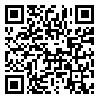Volume 4, Issue 3 (8-2022)
alkhass 2022, 4(3): 1-4 |
Back to browse issues page
Download citation:
BibTeX | RIS | EndNote | Medlars | ProCite | Reference Manager | RefWorks
Send citation to:



BibTeX | RIS | EndNote | Medlars | ProCite | Reference Manager | RefWorks
Send citation to:
Sarabandi S, Torabi F, Rostami A. Investigating the Toxin Sequences of the Toxin-Antitoxin System between Mycobacterium Tuberculosis and Mycobacterium Bovis. alkhass 2022; 4 (3) :1-4
URL: http://alkhass.srpub.org/article-4-161-en.html
URL: http://alkhass.srpub.org/article-4-161-en.html
Department of Veterinary Science, Karaj Branch, Islamic Azad University, Karaj, Iran.
Abstract: (797 Views)
Tuberculosis counts as a significant clinical disease caused by Mycobacterium tuberculosis or, less commonly, Mycobacterium Bovis [1]. Also, Toxin antitoxin is a unique system in bacterias such as Mycobacterium, and different types of protein contribute to this system. In this research amino acid sequences of type 2 toxin protein have been analyzed between Mycobacterium Bovis and Mycobacterium tuberculosis as the principal cause of tuberculosis. Data analyses indicate the presence of different amino acids in MazF7, VapC11, VapC18, vapC24, VapC48, and VapC49 among two variant. understanding of this construction leads to measuring the resistant parameter more clearly against the drugs. Moreover, the presence of many similarities in the toxin sequence confirmed that these two variants more probably come from the same ancestor.
Type of Study: Research |
Subject:
Microbiology
Received: 2022/03/15 | Revised: 2022/06/23 | Accepted: 2022/07/15 | Published: 2022/08/10
Received: 2022/03/15 | Revised: 2022/06/23 | Accepted: 2022/07/15 | Published: 2022/08/10
References
1. Kubica T, Rüsch-Gerdes S, Niemann S. Mycobacterium bovis subsp. caprae caused one-third of human M. bovis-associated tuberculosis cases reported in Germany between 1999 and 2001. J Clin Microbiol. 2003; 41(7): 3070-3077. [DOI:10.1128/JCM.41.7.3070-3077.2003] [PMID] [PMCID]
2. Zimpel CK, Patané JSL, Guedes ACP, de Souza RF, Silva-Pereira TT, Camargo NCS, Guimaraes AMS. Global distribution and evolution of Mycobacterium. Loiseau C, Menardo F, Aseffa A, Hailu E, Gumi B, Ameni G, Brites D. An African origin for Mycobacterium bovis. Evol Med Publ Health, 2020(1); 49-59. [DOI:10.1093/emph/eoaa005] [PMID] [PMCID]
3. ISO/DIS 16000-6.2 (2002) Indoor Air - Part 6: Determination of Volatile Organic Compounds in Indoor and Chamber Air by Active Sampling on TENAX TA Sorbent, Thermal Desorption and Gas Chromatography using MSD/FID. Geneva, International Organization for Standardization.
4. Rogall T, Flohr T, Böttger EC. Differentiation of Mycobacterium species by direct sequencing of amplified DNA. Microbiol. 1990; 136(9): 1915-1920. [DOI:10.1099/00221287-136-9-1915] [PMID]
5. Van Melderen L. Toxin-antitoxin systems: why so many, what for? Curr Opin Microbiol. 2010; 13(6): 781-785. [DOI:10.1016/j.mib.2010.10.006] [PMID]
6. Stieber D, Gabant P, Szpirer CY. The art of selective killing: plasmid toxin/antitoxin systems and their technological applications. Biotechniques, 2008; 45(3): 344-346. [DOI:10.2144/000112955] [PMID]
7. Syed MA, Lévesque CM. Chromosomal bacterial type II toxin-antitoxin systems. Can J Microbiol. 2012; 58(5): 553-562. [DOI:10.1139/w2012-025] [PMID]
8. Lewis K. Programmed death in bacteria. Microbiol Mol Biol Rev. 2000; 64(3): 503-514. [DOI:10.1128/MMBR.64.3.503-514.2000] [PMID] [PMCID]
9. Cook GM, Robson JR, Frampton RA, McKenzie J, Przybilski R, Fineran PC, Arcus VL. Ribonucleases in bacterial toxin-antitoxin systems. Biochim Biophys Acta (BBA)-Gene Regul Mech. 2013; 1829(6-7): 523-531. [DOI:10.1016/j.bbagrm.2013.02.007] [PMID]
10. Brantl S. Bacterial type I toxin-antitoxin systems. RNA Biol. 2012; 9(12): 1488-1490. [DOI:10.4161/rna.23045] [PMID]
11. Singletary LA, Gibson JL, Tanner EJ, McKenzie GJ, Lee PL, Gonzalez C, Rosenberg SM. An SOS-regulated type 2 toxin-antitoxin system. J Bacteriol. 2009; 191(24): 7456-7465. [DOI:10.1128/JB.00963-09] [PMID] [PMCID]
12. Makarova KS, Wolf YI, Koonin EV. Comprehensive comparative-genomic analysis of type 2 toxin-antitoxin systems and related mobile stress response systems in prokaryotes. Biol Direct, 2009; 4(1): 1-38. [DOI:10.1186/1745-6150-4-19] [PMID] [PMCID]
13. Schuster CF, Mechler L, Nolle N, Krismer B, Zelder ME, Götz F, Bertram R. The MazEF toxin-antitoxin system alters the β-lactam susceptibility of Staphylococcus aureus. PloS One, 2015; 10(5): e0126118. [DOI:10.1371/journal.pone.0126118] [PMID] [PMCID]
14. Miallau L, Faller M, Chiang J, Arbing M, Guo F, Cascio D, Eisenberg D. Structure and proposed activity of a member of the VapBC family of toxin-antitoxin systems: VapBC-5 from Mycobacterium tuberculosis. J Biol Chem. 2009; 284(1): 276-283. [DOI:10.1074/jbc.M805061200] [PMID] [PMCID]
15. Gupta A, Venkataraman B, Vasudevan M, Gopinath Bankar K. Co-expression network analysis of toxin-antitoxin loci in Mycobacterium tuberculosis reveals key modulators of cellular stress. Sci Rep. 2017; 7(1): 1-14. [DOI:10.1038/s41598-017-06003-7] [PMID] [PMCID]
| Rights and permissions | |
 |
This work is licensed under a Creative Commons Attribution-NonCommercial 4.0 International License. |










